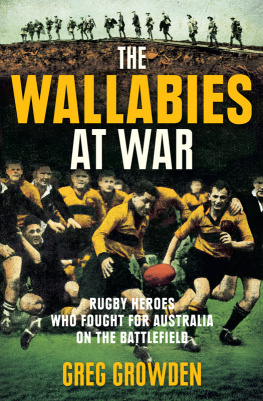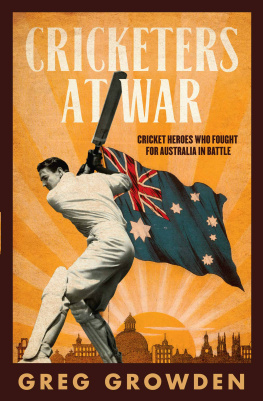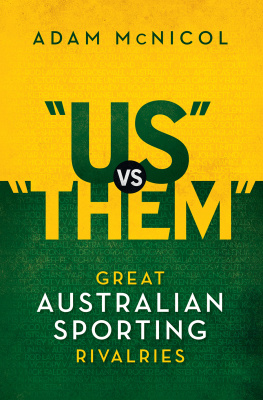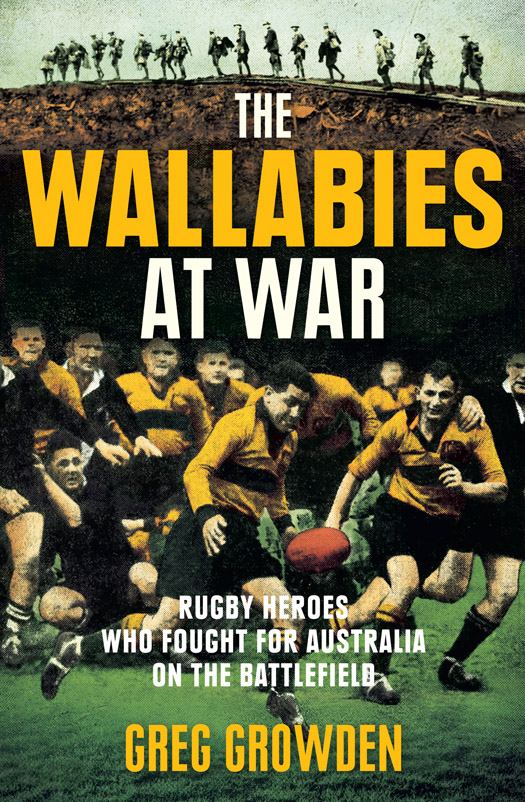To Tim Long and Bobby Hale
for saving me on the Kokoda Track
CONTENTS
Guide
War and Australian rugby have a deep connection. Australias leading rugby representatives have been involved in numerous major battles, including the Sudan, Boxer Rebellion, Boer War, the First and Second World Wars, Korea and Vietnam.
In 1882, when a Queensland team travelled to Sydney to play NSW in Australias first representative intercolonial rugby match, the only recent battle of note was when Ned Kelly unsuccessfully took on the constabulary at Glenrowan. Such is life did not then incorporate getting caught up in other countries squabbles. This was soon to change. Australia, although physically isolated from Britain and the rest of the British Empire, rigidly supported a supposedly protective Mother Country, and willingly provided troops for the Sudan in 1885, and beyond. Among those who went away to defend Britain and her empire were soldiers who had learnt on the Australian rugby field the qualities required to survive in a battle.
When Australia comprising players from NSW and Queensland played its first rugby Test match in 1899, the players wanted to show their opponents Great Britain how they had picked up and run with the English private school game. That year Australia bolstered the British Empires stocks by providing troops to help sort out an imperial tiff on the South African veldt. Many of the Australians who fought beside the British credited their rugby roots for their athleticism, drive and dedication to the Boer War cause. Several years after the Australian team made its first Wallaby tour of Great Britain in 190809, the rugby fraternity en masse embraced the call to arms when Britain declared war on Germany.
Rugby, through its distinct Australian middle-upper class school links, was regarded as the game which upheld British values and devoted itself to defending the empire. To boost enlistment, it was constantly expressed how rugby was the ideal preparation for a soldier.
As The Winger wrote in The Referee sports newspaper in September 1914: The Rugby Union footballers seem specially adapted and inclined for the work. The physical, moral and mental education of the 15-a-side game serves in a better way than any code for the preparation necessary to face a grim and stern struggle.
The Australian Imperial Force (AIF) ranks soon overflowed with rugby fanatics.
There were major ramifications. Apart from losing countless important footballers to the trenches, the consequences of war almost saw the rugby code disappear. The First World War wiped out the game for well over a decade in Queensland, previously a formidable rugby state. The impact of war both strangled and revived the code in Australia.
Then again, the Australian game has always been one of contrasts and contradictions, gutted and bolstered by division. The bitter amateur/professionalism divide which came with the introduction of rugby league in Australia in 1907 hit rugby union hard. After losing its best players, many of whom moved to league not just because of money but through disenchantment with short-sighted rugby officials who showed only scanty interest in their welfare, rugby crowds and interest slumped.
While rugby league, which had lured across the other codes big stars including Dally Messenger and Chris McKivat, consolidated its position as the leading winter football code in several states during the Great War, rugby union, through its officials calling off all serious competition, had become almost forgotten.
In NSW, rugbys strongest territory, it required frontline soldiers who had endured so much at Gallipoli and the Western Front to resuscitate the code after the war, with a successful AIF team rugby tour reminding all that the 15-man game was still breathing and warranted a revival.
When Britain and Germany declared war in September 1939, rugby was once more in a shaky state. A Wallabies tour, aimed at rewarding those who hadnt been lured to league by offering them the most alluring overseas sporting trip of all, had to be abandoned. Then they lost too many men to the war. But once again rugby survived post-war through the dynamic efforts of those 15-man devotees who had served.
Since then, Australian rugby has actively encouraged its military links, with representative player and official ranks including those who have served in Korea, Vietnam, East Timor, Iran and Afghanistan.
On numerous occasions, war has forced rugby to get its act together. War emphasised the character and will of many who played at the highest level. But war led to enormous dilemmas within the rugby ranks.
Ten Wallabies were killed during the First World War. Nine died in the Second World War. Numerous state representatives were victims. Some suffered excruciating deaths. The Australian rugby ranks produced soldiers of varying standards. Some were decorated. Others were shirkers. There were inspirational battlefront leaders and deserters. Decorated fighter pilots and prisoners of war (POWs) with extraordinary escape stories are mixed up with eccentrics, suspected spies and those caught up in messy court martials. There was a fair share of philosophers, pisspots, leaders and lecherous individuals, as well as those who completely lost the plot.
Wallabies at War focuses on those rugby footballers with compelling tales to tell. And there are many. Some are sad, some stirring, some involve unexpected mirth or strange twists and turns where ingenuity and courage are rewarded. It is not just confined to players who attained Wallaby Test status. For many decades, a player would be tagged a Wallaby if he represented Australia overseas. But from the 1980s onwards, a Wallaby became someone who had been selected for Australia at home or away. For the purposes of this book, a Wallaby is someone who played at the highest level of their time. It also includes those who played rugby at state level who on the battlefront boasted moments of valour.
A few have already been glorified in print. But the bulk of those worthy of accolades or close attention have either been ignored or forgotten. Sometimes the footballer wanted it that way, desperate to forget those horrid, maniacal times.
Countless footballers, as courageous on the battlefield as they were on a rugby pitch, were badly affected by war. Families collapsed under the strain of bureaucratic bungling while endlessly waiting for any news of lost loved ones.
Yet several overcame dreadful experiences to somehow resurrect their footballing careers. The rapid recovery of those who returned to the Test ranks following years of torture and hardship is a testament to the human spirit. Most didnt talk about what they had gone through, believing it nothing more than their patriotic duty to represent their country on the frontline as vehemently as they did when wearing the national rugby colours.
But many had important stories to tell, ranging from heroic to hilarious. These deserve greater recognition. That is the aim of Wallabies at War.
James McManamey and Brian Pockley
Family, admirers, historians and the curious assembled in the Blue Mountains near Sydney in September 2015 to attend a commemorative service for one of Australias most admired sportsmen.
James Whiteside Fraser McManamey is not one of Australian rugbys most famous names, but one cherished by those with a rich, broad knowledge of the game.
The small, reputedly haunted church at the Woodford Academy a 180-year-old establishment that has been a highway inn, police station, private residence, guesthouse, sanatorium and school a place with which the McManamey family have been deeply involved, was at capacity as we heard of his feats, and sad death, 100 years to the day at Gallipoli.











